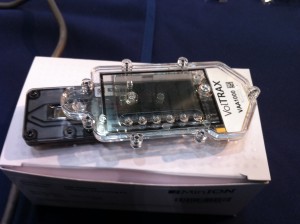Nanopore sequencing and microfluidics are among the technologies set to disrupt the Life Sciences industry. What Is your business doing today to remain relevant tomorrow?
Recently at the Festival of Genomics in London I was fortunate to get my hands on the latest breakthrough-in-the-making by Oxford Nanopore. They presented a prototype DNA sample preparation device for MinION sequencing dubbed “VolTRAX”:

Oxford Nanopore VolTRAX prototype on MinION, January 2016. © Klaus Hentrich.
It is programmable, about the size of a credit card and docks directly on the MinION from which it also receives its power. VolTRAX is a disposable device supposed to handle “original biological samples”; from talking to one of their technical specialists, more details are unavailable at this point, as product specifications are yet to be nailed down.
VolTRAX works by electrowetting, or “digital microfluidics”– the basic principle is the same as Illumina’s NeoPrep, while the latter weighs some 20 kg and is clearly not designed for in-field use.
VolTRAX launch is planned for this year (a more specific window has not yet been announced). While important questions such as supported sample types and sample volumes are still open, this is an exciting product launch to look forward to. Similar to what Fluidigm did with their C1, we can expect Votrax to be launched initially with one or two key applications (such as pathogen sequencing from whole blood) and further capabilities added later on.
Together with Oxford Nanopore’s real-time cloud-based sequence analysis, the MinION-VolTRAX combination will for the first time enable mobile DNA sequencing anywhere, as long as there is a decent internet connection; and future iterations of their software may even remove this restriction.
This will fundamentally change our idea of a molecular biology “laboratory”, and will open up countless possibilities. What do you think will be the “killer application”?
Interesting!